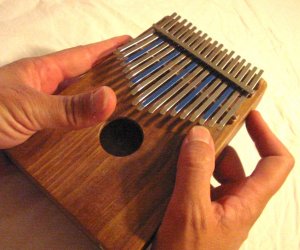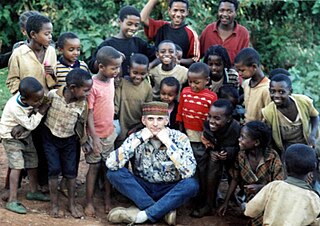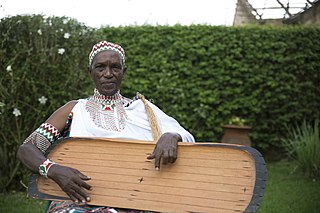
Swahili, also known by its native name Kiswahili, is a Bantu language and the native language of the Swahili people. It is one of two official languages of the East African Community (EAC) countries, namely Burundi, Kenya, Rwanda, South Sudan, Tanzania, and Uganda. It is a lingua franca of other areas in the African Great Lakes region and East and Southern Africa, including some parts of the Democratic Republic of the Congo (DRC), Malawi, Mozambique, the southern tip of Somalia, and Zambia. Swahili is also one of the working languages of the African Union and of the Southern African Development Community. The number of Swahili speakers, be they native or second-language speakers, is estimated to be approximately 200 million.

The xylophone is a musical instrument in the percussion family that consists of wooden bars struck by mallets. Like the glockenspiel, the xylophone essentially consists of a set of tuned keys arranged in the fashion of the keyboard of a piano. Each bar is an idiophone tuned to a pitch of a musical scale, whether pentatonic or heptatonic in the case of many African and Asian instruments, diatonic in many western children's instruments, or chromatic for orchestral use.

Mbira are a family of musical instruments, traditional to the Shona people of Zimbabwe. They consist of a wooden board with attached staggered metal tines, played by holding the instrument in the hands and plucking the tines with the thumbs, the right forefinger, and sometimes the left forefinger. Musicologists classify it as a lamellaphone, part of the plucked idiophone family of musical instruments. In Eastern and Southern Africa, there are many kinds of mbira, often accompanied by the hosho, a percussion instrument. It is often an important instrument played at religious ceremonies, weddings, and other social gatherings. The "Art of crafting and playing Mbira/Sansi, the finger-plucking traditional musical instrument in Malawi and Zimbabwe" was added to the UNESCO Representative List of the Intangible Cultural Heritage of Humanity in 2020.
Given the vastness of the African continent, its music is diverse, with regions and nations having many distinct musical traditions. African music includes the genres Jùjú, Fuji, Highlife, Makossa, Kizomba, Afrobeat and others. The music and dance of the African diaspora, formed to varying degrees on African musical traditions, include American music like Dixieland jazz, blues, jazz, and many Caribbean genres, such as calypso and soca. Latin American music genres such as zouk, bomba, conga, rumba, son cubano, salsa music, cumbia and samba, were founded on the music of enslaved Africans, and have in turn influenced African popular music.

Zimbabwean music is heavily reliant on the use of instruments such as the mbira, Ngoma drums and hosho. Their music symbolizes much more than a simple rhythm, as the folk and pop style styled music was used as a symbol of hope for Zimbabweans looking to gain independence from Rhodesia. Music has played a significant role in the history of Zimbabwe, from a vital role in the traditional Bira ceremony used to call on ancestral spirits, to protest songs during the struggle for independence. The community in Zimbabwe used music to voice their resistance to their oppression, as one of the only weapons they had available to fight back with. In the eighties, the Music of Zimbabwe was at the center of the African Music scene thanks to genres such as Sungura and Jit. However, several performers were banned by state TV and radio leading to the closing of several music venues.

The African Great Lakes are a series of lakes constituting the part of the Rift Valley lakes in and around the East African Rift. They include Lake Victoria, the third-largest fresh water lake in the world by area, Lake Tanganyika, the world's second-largest freshwater lake by volume and depth, and Lake Malawi, the world's eighth-largest fresh water lake by area. Collectively, they contain 31,000 km3 of water, which is more than either Lake Baikal or the North American Great Lakes. This total constitutes about 25% of the planet's unfrozen surface fresh water. The large rift lakes of Africa are the ancient home of great biodiversity, and 10% of the world's fish species live in this region.

A lamellophone is a member of the family of musical instruments that makes its sound by a thin vibrating plate called a lamella or tongue, which is fixed at one end and has the other end free. When the musician depresses the free end of a plate with a finger or fingernail, and then allows the finger to slip off, the released plate vibrates. An instrument may have a single tongue or a series of multiple tongues.
Taarab is a music genre popular in Tanzania and Kenya. It is influenced by the musical traditions of the African Great Lakes, North Africa, the Middle East, and the Indian subcontinent. Taarab rose to prominence in 1928 with the advent of the genre's first star, Siti binti Saad.
Shona music is the music of the Shona people of Zimbabwe. There are several different types of traditional Shona music including mbira, singing, hosho and drumming. Very often, this music will be accompanied by dancing, and participation by the audience. In Shona music, there is little distinction between the performer and the audience, both are often actively involved in the music-making, and both are important in the religious ceremonies where Shona Music is often heard.

Ngoma are musical instruments used by certain Bantu populations of Africa. Ngoma is derived from the Kongo word for "drum". Different Bantu-inhabited regions have their own traditions of percussion, with different names for their instruments. In Kikongo, "ngoma" is used by extension to signify specific dances, social occasions and rhythms. In Swahili, the word Ngoma is used to describe the drums themselves as well as music and dance together as a joint cultural practice.

The individual member states of the African Union (AU) coordinate foreign policy through this agency, in addition to conducting their own international relations on a state-by-state basis. The AU represents the interests of African peoples at large in intergovernmental organizations (IGO's); for instance, it is a permanent observer at the United Nations' General Assembly.

In many parts of sub-Saharan Africa, the use of music is not limited to entertainment: it serves a purpose to the local community and helps in the conduct of daily routines. Traditional African music supplies appropriate music and dance for work and for religious ceremonies of birth, naming, rites of passage, marriage and funerals. The beats and sounds of the drum are used in communication as well as in cultural expression.

Also known as muzungu, mlungu, musungu or musongo, mzungu is a Bantu word that means “wanderer” originally pertaining to spirits. The term is currently used in predominantly Swahili speaking nations to refer to white people dating back to 18th century. The noun Mzungu or its variants are used in Kenya, Tanzania, Malawi, Rwanda, Burundi, Uganda, Democratic Republic of the Congo, Comoros, Zimbabwe, Mayotte, Zambia and in Northern Madagascar dating back to the 18th century.

Andrew Tracey is a South African ethnomusicologist, promoter of African music, composer, folk singer, band leader, and actor. His father, Hugh Tracey (1903–1977), pioneered the study of traditional African music in the 1920s–1970s, created the International Library of African Music (ILAM) in 1954, and started the company African Musical Instruments (AMI) which manufactured the first commercial kalimbas in the 1950s.
The Chopi are an ethnic group of Mozambique. They have lived primarily in the Zavala region of southern Mozambique, in the Inhambane Province. They traditionally lived a life of subsistence agriculture, traditionally living a rural existence, although many were displaced or killed in the civil war that followed Mozambique's liberation from Portuguese colonial rule in 1975. In addition, drought forced many away from their homeland and into the nation's cities.
Queen Marimba is a folk hero whose accomplishments have become part of the folklore of Africa. As is customary in most African cultures she is considered to be a god and was one of the immortals. She led the Akamba tribe in East Africa in very ancient times across the Ukambani plains in present day Kenya, stretching across the Kilimanjaro plains in present day Tanzania. There has been scant research done on her and presently the most notable source for information on her life comes from the writings of Vusa'mazulu Credo Mutwa. He asserts in his book; Indaba My Children, that she was the mother of the Akamba people at the time when they were getting to know their Maasai neighbours. Various renditions of his book have been published since the late 60's, including "My People, My Africa", "Indaba My Children" and "Africa Is My Witness."
The malimbe is a type of xylophone from the Congo which is described as having both male and female counterparts; the former has 15 wooden bars, the latter has nine. "Malimbe" also refers to a lamellaphone or mbira type instrument amongst the Nyamwezi of Tanzania.

Trough zithers are a group of African stringed instruments or chordophones whose members resemble wooden bowls, pans, platters, or shallow gutters with strings stretched across the opening. A type of zither, the instruments may be quiet, depending upon the shape of the bowl or string-holder. Sound is often amplified with the addition of a gourd resonator. Instruments have been classed into five different types, based on shape.












